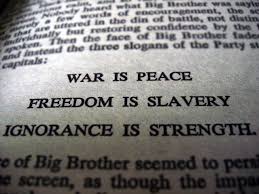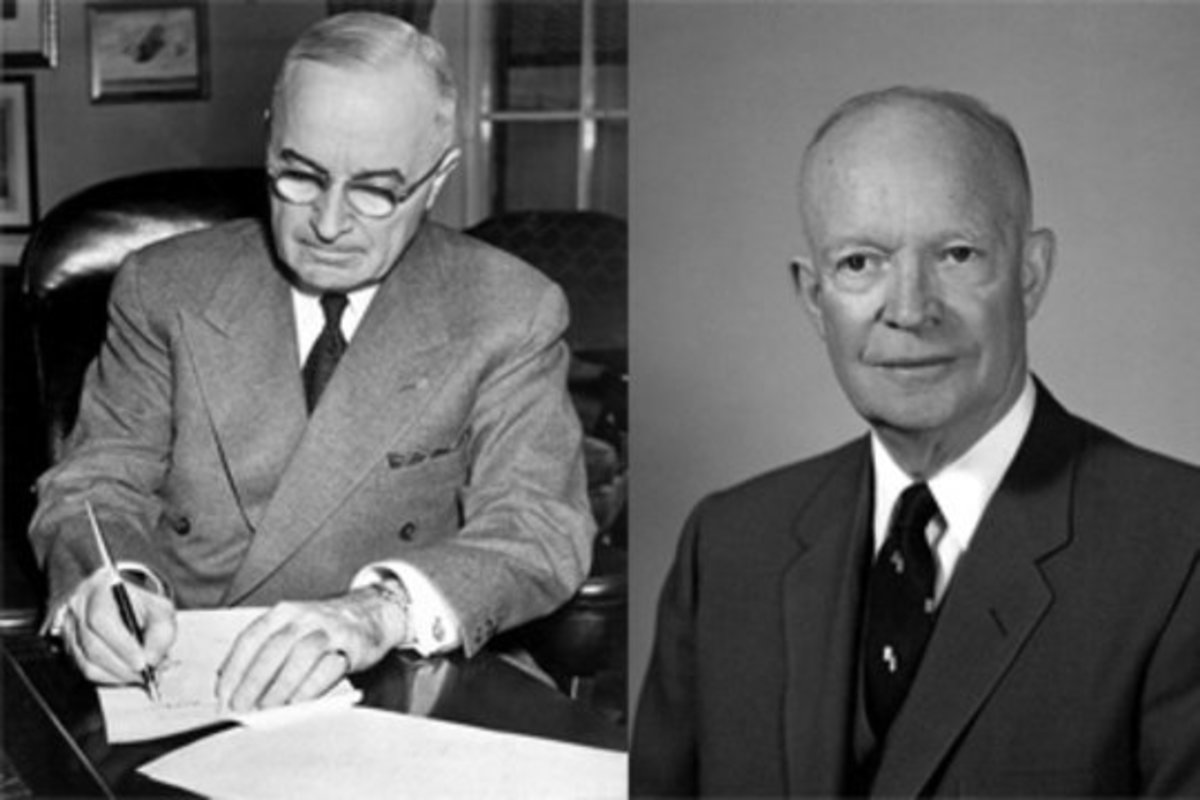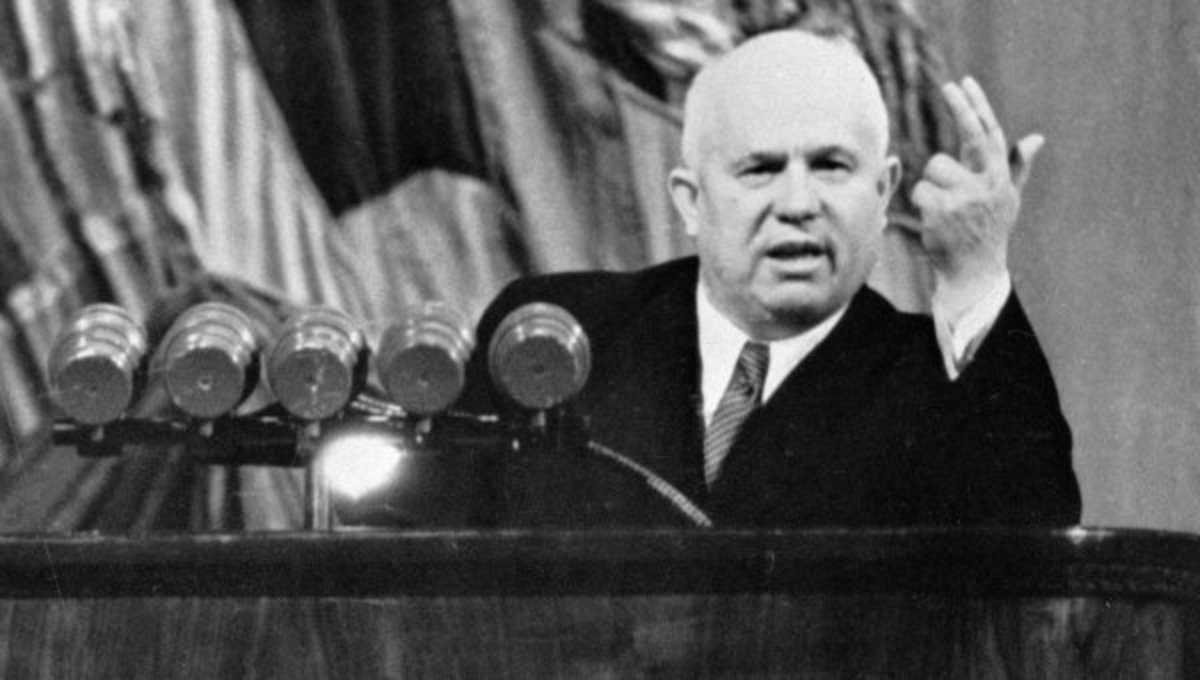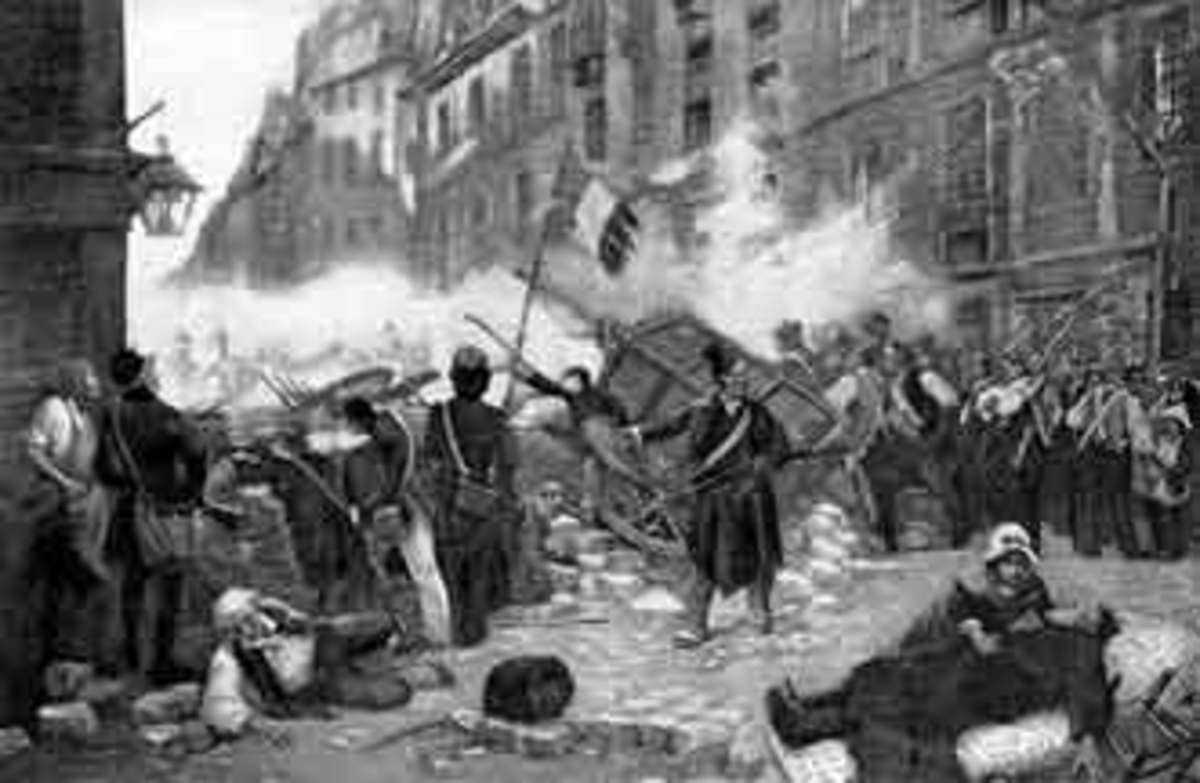Language and Politics: The American-Soviet Cold War (Part One)

Who What Where Why How?
What is communism?
Nobody knows.
Nobody can define it.
Nobody has ever known.
Nobody has ever been able to define it.
"Communism" is a nebulous, phantom-concept, with no substance, which is why nobody knows what it is or can define it.
You cannot escape this conundrum by renaming it Marxism.
Someone can straighten me out, if I'm mistaken---but I don't believe I am---but Karl Marx never wrote a thing about "communism" or "socialism." He was too busy using every resource he had in analyzing capitalism, because he hoped to give succeeding generations some of the tools they would need to overthrow it.
"Marxism," then---if such a thing can be said to exist---is an analytical approach of theorizing about capitalism.
Here's a research project for media historians.
1. Where did the term "communism" actually come from? Where did it first appear and come into use? Russia (and the Soviet Union)? Or American (and the West)?
2. If the term originated in America (and the West), then how, exactly, was it derived? Did somebody actually go to Russia and see a group of Russians doing activities, about which they said something like: (Oh, this is what our system of "communism" is all about. Let us tell you about it.)?
3. If not, again, how exactly was the term "communism" derived?
4. Yes, it is true that there were people who called themselves "communists" and said that they were practicing "communism." But the question is: Did their ownership of the term come before or after America (and the West) told them that they were "communists," practicing "communism"---or witches practicing witchcraft?
Here's the thing.
It was known just how capitalistic, so-called Soviet "communism" was, in the late-1950s. For example, in his 1959 book, The Status Seekers, Vance Packard wrote:
"The Soviet Union, despite its professions of achieving a society of true equality, is becoming more precisely stratified each year. The need of the expanding industrial machine for a hierarchy of managers and specialists as well as workers of varying skills provided, and in fact perhaps demand, a social structure to match" (1).
Notice, here, that Packard---perhaps along with others at the time---understood the Soviet professed understanding of "communism," as a system of "true equality," in contrast to "capitalism," by implication. But he is saying that the objectively perceivable "stratification" of the Soviet industrial workplace and society, gives the lie to "communism," if by that one meant "true equality."
Alex Inkeles, then with the Russian Research Center at Harvard, concluded that Russia, under the "communists," had evolved a ten-class social system. Classes ranged from the ruling elite (officials, scientists, top artists, and writers), down through managers, bureaucrats, three classes of workers, two classes of peasants, to the slave laborers. To make all of this very official, Russia had been requiring more and more of its millions of citizens to wear uniforms to show their exact position within the system (2).
I think people got overly hung up on the uniforms thing.
In 1958 a group of Russian managers and technicians visited America. They were billed by the Soviets as "ordinary." But some inquiry revealed that their average income was five times that of the typical Soviet worker (3).
The Soviet Union implemented a number of five-year plans. Russian industrial production rose impressively. Steel output increased by about 9 percent a year through the 1950s. Between 1960 and 1973, per capita growth in the Soviet Union averaged 3.4 percent a year to the 3 percent of the United States and Europe's 4.4 percent (4).
In his 1952 study of Russia's economic development, Alexander Gerschenkron described 'an approximate sixfold increase in the volume of industrial output' as 'the greatest and longest [spurt of industrialization] in the history of the country's industrial development,' through this 'great industrial transformation engineered by the Soviet government' had 'a remote, if any' relation to 'Marxian ideology, or any socialist ideology for that matter' (5).
Noam Chomsky: "In his studies 10 years later of long-term trends in economic development, Simon Kuznets listed Russia among the countries with the highest rate of growth per capita product, along with Japan and Sweden, with the US---having started from a far higher peak---in the middle range over a century, slightly above England" (6).
Here's the point.
Surely the leaders of the United States knew that the Soviet Union (Russia) was as capitalist as they were.
Surely they understood that different countries practiced capitalism in different ways.
Surely they understood that differences in capitalist practices, between countries, had/has to do with the proportion of the economy held by the state and that held by private enterprise.
The question for us, then, is: Why was Russian capitalism marked out for special calumny, special ostracizing, and indeed, demonization as "communism," something that had to be contained, then later overthrown at all costs by the forces of light?
Surely the leaders of the United States knew something of our own economic history. There was a time when the United States had every single---and I mean every single---feature, or tried to get every single feature of an economy that we would associate with "communism," or "socialism," or "social democracy," and even "anarchism," in some respects.
"Communistic" or "Socialistic" or "Social Democratic" American Economic Features Here Today, Gone Tomorrow
For example, there was a time when corporations were not perpetually standing entities. In the early republican period, states, not the federal government, issued corporate charters. These charters were temporary, only allowing the 'corporation' to exist for a fixed period of time, to accomplish specific purposes. The corporation had to be dissolved if the charter was not renewed. The charters put limits on a corporation's borrowing, ownership of land, and sometimes profits (7).
Members of the corporation were liable for all debts incurred by the entity during their period of membership. Large and small investors had equal voting rights; and interlocking directorates were legally prohibited (8).
Furthermore, these charters often contained revocation clauses. State legislatures retained the right to withdraw the charter of any corporation that, in their judgment, failed to serve the public interest. By 1800, only about 200 corporate charters had been granted by the states (9).
In 1819, the US Supreme Court ruled against the state of New Hampshire, in its attempt to revoke the charter issued to Dartmouth College by King George III, before American independence. The court overruled on the grounds that the charter had not contained a revocation clause. After the American Civil War, a more pro-business-oriented judiciary began to chip away at the legal restraints on the power and authority of corporations. The courts began to put new precedents in place, which eliminated jury trials in deciding fault and assessment of damages, in cases involving corporate-caused harm; and which took away the right of states to oversee corporate rates of return and prices (10).
Pro-business judges started ruling that workers were responsible for causing their own injuries on the job. The judiciary also limited the liability of corporations for damages they caused, and declared wage and hour laws unconstitutional. Finally, in 1886 the Supreme Court ruled in the Santa Clara v. Southern Pacific Railroad case, that a private corporation is a natural person, entitled to the protection of the Bill of Rights (11).
There was a time, in the industrial sector of the American economy, when you had effective worker-control of factories. First of all, workers set their own hours, arriving for work and going home as they saw fit (12). Not only that, but workers had effective control of the workplace because they had actual control of the labor process. It was workers, themselves, who knew how to make a product from A to Z. Such expertise resided nowhere else and with nobody else. There were owners and managers, but their control was often more formal than real; they were rather like "figureheads," if you will. Basically, if you were an owner or manager, back in the day, you had to hang back, stay loose, and let the workers do their thing (13).
How did this change?
Sociologist John Bellamy Foster wrote: "As corporations and their workforces and factories got bigger with the rise of monopoly capitalism, however, it became possible to extend the division of labor and therefore to exercise greater top-down managerial control. This took the form of the new system of management, or 'Taylorism,' within concentrated industry. Control of the conception of the labor process was systemically removed from the workers and monopolized by management. Henceforth, according to this managerial logic, workers were merely to execute commands from above, with every movement governed down to the smallest detail" (14).
Again, John Bellamy Foster: "The chief result of the introduction of scientific management into industry, as Harry Braverman explained in 1974 in Labor and Monopoly Capital, was the degradation of working conditions for most workers. Increasingly, monopoly capitalist society was characterized by a polarization of skill, with only a limited demand for a relatively small number of highly skilled workers, as compared with masses of unskilled workers" (15).
Now then, what does all that technical-sounding language from John Bellamy Foster mean?
Before the "Rise of the Machines"
1. You have a plant with workers, who know how to make a product, 'X,' from A to Z, as it were.
2. It is the workers themselves who have this knowledge and expertise.
3. There are owners and managers, but their role is formal, titular. They, more or less, work right alongside the regular workers. Social polarization between owners and managers and regular workers is not very sharp.
4. Because the workers contain all of the knowledge of how to make product 'x' from A to Z, owners and managers are not really in a position to interfere, as far as that goes. Owners and managers, at this time, have to, more or less, hang back, stay loose, and let the workers do their thing.
5. Because workers have all the knowledge and expertise, and are necessarily allowed to do the job as they see fit, they come and go as they see fit. That is, their work schedule is left to their discretion.
6. Workers, at this time, work in whatever condition they feel like working in. Which is to say "sober" or "drunk." Drinking throughout the workday was expected and routine. Employers were often expected to supply alcohol for the workers (16). Of course, we have to keep in mind that in the United States at that time, you really could not drink the water (17).
With the introduction of machines
7. Let's say that workers had always made 'X' with their own hands and expertise and knowledge; and that they did this in, say, five steps---Step 1, Step 2, Step 3, Step 4, Step 5.
8. One day the boss comes in with a newfangled machine and says, "Men, from now on, this here machine is gonna do Steps 1 and 2."
9. He implements what he said about the machine. It does Steps 1 and 2, leaving Steps 3-5 in human hands.
10. Because the machine is a machine, it can do Steps 1 and 2 much, much faster than human hands.
11. What this means is that a way has to be found to get the humans to do Steps 3-5 much faster than they ever had done before, so that they may somewhat match the tremendous output of the machine, so that the product 'X' can be made and sent out the door as quickly as possible.
12. This is where 'Taylorism' or 'scientific management' comes in. To quote former U.S. Secretary of Labor, Robert B. Reich: "In the first decades of the twentieth century, productivity again surged. Sweatshops and mills were replaced by large manufacturing plants, inspired by Frederick Winslow Taylor's new theories of 'scientific management,' which broke down every factory job into highly specialized and repetitive steps. Henry Ford's assembly line became the model. Not only could workers positioned along the line produce more cars in a shorter time but production could be concentrated in a few giant factories and materials could be bought in bulk at great savings" (18).
13. Notice that what we have, here, is the narrowing of the purview of workers, while, at the same time, increased speed and repetition is demanded from workers. In other words, because the machine takes over Steps 1 and 2, as time goes by, workers will forget how to do those steps manually, since they no longer need to do them.
14. This process is called the "de-skilling" of the worker. Technology is being used in such a way as to take away knowledge and expertise from the workforce. At the same time they must do their simplified tasks with increasing speed.
With the "Rise of the Machines"
15. Five years later, as worker-memory of how to do Steps 1 and 2 manually, is quickly fading, the boss comes in with either a new machine or modifications on the original machine and says, "Now the machine will do Steps 1, 2, and 3."
16. This means that now, only Steps 4 & 5 will be left in human hands.
17. But once again, with the machine being the machine, with the tremendous, beyond-human speed that it has, this means that Step 4 in the process is arrived at even faster than it had been, five years before, when the machine had first been introduced.
18. What this means is that Steps 4 and 5---left to human hands---must be done even faster than they had been five years before, when the machine was first introduced.
19. Here, we would look for an intensification of the application of "scientific management," to yet again, increase the human output, to, once again, somewhat match the increased machine output, so that the product can be made and moved out the door, as quickly as possible, yet again.
20. To paraphrase John Bellamy Foster, this process is the main reason why working conditions for workers, have gone down the crapper for the last one-hundred-fifty years.
There have been a number of social and cultural consequences, in the United States, of the "Rise of the Machines," as it were.
I. Education. With the proliferation of machines, it becomes necessary for somebody to promote a basic level of education, particularly literacy and numeracy, if for no other reason than for workers to be able to read instructions on packing cases and machines, so that they can be properly operated.
Does this mean that we should celebrate business as "promoters of education"?
I would hold off on the ticker tape parade!
II. The rise of the machines, while de-skilling masses and masses and masses of workers, does call for a small number of highly skilled workers who know how to fix these machines.
III. Now that you have machines all over the plant, what you will want to do now is turn them all on and off at the same time everyday. With this will come a need to make sure the workers all show up and leave at the same time, everyday. You require workers to take their breaks at same time as well. You find yourself having to regiment the behavior of workers both in and out of the factory, more and more.
IV. Because you now have all of those powerful, dangerous machines all over the factory, you need your workers to have their wits about them. This means that you require them to work sober, because the last thing you need is a drunk worker being careless and getting his darn fool arm lopped off, and getting blood all over your floor and slowing down production. You promote coffee-drinking for workers as a substitution of alcohol.
V. With the rise of the machines requiring increasing regimentation of worker behavior, you need help in keep the ship going in the right direction. Therefore, you bring in layers of intermediary professional managers and supervisors to regulate the increasingly complex industrial business apparatus.
VI. The insertion of intermediating layers of management put increasingly social distance between you, the plant owner, and your workers. Gone are the days when you and your men spend many happy hours working side-by-side, as near equals. You start to see yourself as fundamentally different from, and no doubt, better than them.
VII. This means increasing polarization-driven distrust and animosity between workers and employers. The middle managers are let in for the bulk of it because they are seen as the direct representatives of the cold, unfeeling overlord.
VIII. While you enforce a time disciplined, 9-to-5, coffee-drinking regimen upon your workers, you find that no actual presence is not needed a whole lot, at the factory---not with your management team taking care of the details. You find yourself spending more and more time with other men like you, factory owners. You guys spend hours and hours smoking fine cigars, drinking single-malt Scotch, and eating roast beef, at various "clubs."
VIV. The Rise of the Machines made industrial business enterprises exponentially more profitable for the reasons I have outlined.
X. This process gave enabled the Rise of the Corporations, to a level of eminence unknown anywhere else in the world (19).
XI. This, in turn, made the daughters of wealthy industrialists, attractive marriage prospects for cash-strapped European aristocracy (20); and this, in turn, probably increased the sense of social alienation, between owners, managers, and workers.
XII. The Rise of Corporations---fuelled by the Rise of the Machines---creates a situation in which Big Business takes up all the oxygen in the room, as it were. The nature of aspirations are affected. More and more people either want to become business "tycoons," or believe that in order to get ahead, the thing to do is find a way to serve Big Business, in some way. The legal profession needs to become exponentially more sophisticated, to better protect and help expand the private property of the corporations. Politicians pay more and more attention to such entities. The idea of the protection of private property gathers steam as an imperative for law enforcement.
XIII. The rising corporations become an increasingly potent focal point of aspiration, which becomes manifest in the society's cultural production (21).
XIV. I really believe that the Rise of the Machines has not only taken away skill from workers and transferred control of the labor process from the bottom to the top, it has consequently led to the extreme personalization of a corporation's success with the figure of the CEO. The chief executives of the big monopoly interests of the late-nineteenth and early-twentieth centuries, are depicted as The Men Who Built America! The idolization of the corporate CEO.
Conclusion to Part One
De-skilling of Workers
Technology does not have to be used to de-skill workers. It did not have to be used that way before, with workers in the industrial sector, in the United States. Look at the medical field. Everything we hear about robotics tells us that this technology is NOT being used to replace doctors and surgeons. Robotics are being used to enhance the surgeon.
The technology is being used as an extension of the surgeon's hands, making her more effective. It continues to be guided by the knowledge and expertise of the doctor. There is no reason why worker-replacing technology cannot be legally prohibited. If I had the power to do so, I would get a law passed which strictly prohibits ANY worker-replacing technology. Such technology would either have to be scraped or modified into worker-enhancing.
Because we, as a society, have allowed worker-replacing technology to prevail, we hear politicians forever talking about "retraining programs" for blue collar workers. Workers in certain professions are never threatened with obsolescence because new technology is made to serve them rather than replace them.
Wrapping Up
I have started something here, that I intend to continue in part 2 and part 3, if necessary.
Our subject is the origin of the American-Soviet Cold War. What I want to do, first of all, is demolish the argument that it was about "communism." In order to do that I am trying to demonstrate that it is a "phantom-concept," that has no substance.
I plan to do that by showing that the United States, at one time or another, has either had or tried to get every single feature of an economy that can be classified as "socialist," "communist," "anarchist," or "social democratic."
A. We had those "socialistic," "communistic," "anarchistic," or "social democratic" features, not as the result of an implementation of somebody's wholesale, planned vision, but as the result of contingency. We had effective worker-control of industrial factories (a selling point of communist, socialist, anarchic systems) for a while, not as a result of the implementation of a "vision," but just because of the facts of life that workers knew how to do what needed to be done; and owners and managers found a way to take expertise away from them, in the way that I outlined.
B. We have the "capitalist," or some would say, "neoliberal" economy today, again, not as the result of the implementation of a fully worked out plan, but because of reaction.
You have to save room for contingency and improvisation in history. Those with the most power have the most influence in setting the course and steering the vessel.
If I can convince you that the Cold War wasn't about "communism," because we, in the United States and Western Europe, have had ALL of the features we associate with the "Red" political-economy, and that we did not overturn those features for specific, non-ideological reasons and not a plan, then perhaps you will be open to the idea that the conflict was about something else.
Remember, I gave some hint already about the capitalistic nature of so-called Soviet Communism. I have begun the work, in this part, of enumerating the "communistic," "socialistic," "anarchistic," and "social democratic" economic features that the United States have either possessed or tried to get. "Ism" labels are simply not helpful for economic analysis, at the end of the day.
Here, we have looked at a little bit of corporate history. We used to hold a significantly greater share of the economy in state hands because corporations were not always perpetually standing entities. We have more of a private economy because corporations were allowed to become perpetually standing entities due to a Supreme Court judgment. Actually, the checks and balances system worked, although not as I would have hoped.
We used to have worker-control of factories. This changed with the Rise of the Machines.
In other words, we have an economy we call "capitalism." We are often mislead by this neat term into thinking that what we have was the result of the unfolding of an inevitable and complete blueprint. But, of course, it was not. In other words, still, when we use the term 'capitalism,' we are, in a way, retroactively assigning a full plan to a process of contingency and improvisation.
Thank You for reading.
Read part two.
http://wingedcentaur.hubpages.com/hub/Language-and-Politics-The-American-Soviet-Cold-War-Part-Two
References
1. Packard, Vance. The Status Seekers: An Exploration of Class Behavior in America and The Hidden Barriers That Affect You, Your Community, Your Future. David McKay Company Inc., 1959. 19
2. ibid
3. ibid
4. Reich, Robert B. Supercapitalism: The Transformation of Business, Democracy, and Everyday Life. Alfred A. Knopf, 2007. 31
5. Chomsky, Noam. Year 501: The Conquest Continues. South End Press, 1993. 67
6. ibid
7. Korten, David C. When Corporations Rule the World. Berrett-Koehler & Kumarian Press, 1995. 56-57
8. ibid, 56
9. ibid
10. ibid, 57, 59
11. ibid
12. Russell, Thaddeus. A Renegade History of the United States. Free Press, 2010. 7
13. Foster, J.B. (2011, July/August). Education and the Structural Crisis of Capital: The US Case. Retrieved February 4, 2015. paragraph 13
14. ibid
15. ibid, paragraph 14
16. Russell, T. A Renegade History of the United States. 7
17.
18. Reich, Robert B. Supercapitalism: The Transformation of Business, Democracy, and Everyday Life. Alfred A. Knopf, 2007. 18-19
19. Domhoff, G. (2012, February). The Class-Domination Theory of Power. Retrieved February 4, 2015. paragraph 3
20. Phillips, Kevin. Wealth and Democracy: A Political History of the American Rich. Broadway Books, 2002.
21. citation pending







